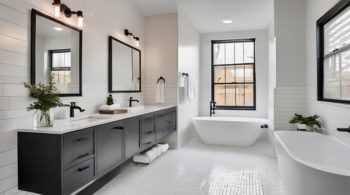If you want your Zigbee smart devices to communicate reliably throughout your home, setting up repeaters and range extenders is essential. These devices boost your network’s signal, fill coverage gaps, and help maintain stable connections, especially in larger or multi-story houses. You’ll need to evaluate placement, compatibility, and interference to get the best results. Understanding these factors will help you expand your Zigbee network effectively and avoid common pitfalls.
What Is Zigbee and How Does It Work?
Zigbee is a wireless communication protocol designed to connect smart devices like lights and sensors in your home efficiently and securely. It supports various Zigbee applications, especially in home automation, by allowing devices to communicate through a low-power mesh network.
This setup not only conserves energy but also extends connectivity across your space. You’ll appreciate Zigbee security too, as it uses 128-bit AES encryption to protect your data from unauthorized access.
Understanding Zigbee Range and Its Limitations
You need to understand that Zigbee’s range varies quite a bit, offering about 10 to 100 meters indoors and up to 300 meters outdoors under ideal conditions.
Keep in mind, walls, furniture, and other obstacles can reduce this range, while interference from Wi-Fi or firmware problems can also cause issues.
Knowing these factors helps you place your devices strategically to maintain a strong, reliable connection throughout your space.
Zigbee Range Basics
Although the wireless signals can travel up to 300 meters outdoors, the practical range inside your home usually falls between 10 and 100 meters, depending on where you place your devices and what obstacles stand in the way.
Zigbee protocols are designed for low power and reliable communication but face signal degradation from walls, furniture, and Wi-Fi interference.
To maintain a strong connection, you need to position devices carefully and understand that each obstacle reduces signal strength.
Using Zigbee repeaters or routers can help extend coverage by relaying signals, overcoming these natural range limitations effectively.
Indoor Vs Outdoor Range
When using Zigbee devices, understanding the difference between indoor and outdoor range is key to setting up a reliable network.
Indoors, Zigbee’s range typically spans 10 to 100 meters, but walls and furniture can reduce signal strength, affecting Zigbee performance.
Outdoors, the range can stretch up to 300 meters under ideal conditions, thanks to fewer obstacles.
To maintain strong signal strength inside, you’ll need to place repeaters strategically, especially in larger or multi-story homes.
Factors Affecting Range
Because Zigbee signals must travel through various obstacles, several factors can greatly affect their range and reliability.
Signal attenuation happens as the signal weakens passing through environmental barriers like walls, furniture, and electronic devices. These obstacles reduce effective range indoors, often limiting it to 10–100 meters.
To combat this, place Zigbee repeaters and routers every 10 to 15 meters, ensuring devices can relay signals efficiently. Strategic positioning minimizes dead zones caused by interference from Wi-Fi or other electronics.
Understanding these factors helps you optimize your Zigbee network’s stability and coverage throughout your home.
The Role of Zigbee Repeaters in Network Expansion
To expand your Zigbee network effectively, you’ll need to rely on repeaters that relay signals between devices, boosting both range and connection stability.
These repeaters, often built into smart bulbs or switches, leverage Zigbee advantages by creating a mesh network that enhances communication without extra hardware costs. Placing at least one repeater per floor guarantees consistent coverage.
However, be aware of repeater limitations: each supports only 3 to 7 non-repeating devices, so overcrowding can weaken performance.
Strategically positioning repeaters between your hub and devices maximizes signal strength and overall network reliability.
Key Factors to Consider When Choosing a Zigbee Repeater
Although Zigbee repeaters may seem similar at first glance, choosing the right one requires careful consideration of several key factors that directly affect your network’s performance.
Start by evaluating Zigbee compatibility considerations to guarantee the repeater works seamlessly with your existing devices. Opt for mains-powered repeaters, as battery-operated ones usually don’t extend signals effectively.
Consider your home’s size—aim for at least one repeater per floor for solid coverage. Look for cost effective solutions like smart bulbs or switches that double as repeaters, saving money while boosting network capabilities.
Proper placement between your coordinator and devices also enhances signal strength.
Step-by-Step Guide to Installing a Zigbee Repeater
When installing a Zigbee repeater, you’ll want to start by choosing the right device, such as the Aqara Hub E1 or a compatible smart plug or bulb that functions as a repeater.
Follow these steps:
- Plug the repeater into a mains power source about halfway between your coordinator and devices.
- Use your Zigbee hub’s app to pair the repeater, ensuring you follow manufacturer instructions closely to maintain Zigbee security.
- Test the connection quality and schedule regular repeater maintenance checks to optimize performance and network safety.
This method enhances your mesh network’s range and reliability effectively.
Strategic Placement for Optimal Zigbee Coverage
Since the effectiveness of your Zigbee network depends heavily on signal strength, placing repeaters strategically is essential for maintaining reliable coverage.
For ideal repeater placement, position devices about 10 to 40 feet apart, ensuring they sit between your Zigbee coordinator and end devices. Use mains-powered gadgets like smart plugs or bulbs as repeaters to boost the mesh network’s reach.
Regularly check signal strength at network edges to spot weak spots needing extra repeaters. Thoughtful repeater placement directly supports signal optimization, reducing dead zones and enhancing overall network stability throughout your home.
Common Interference Sources and How to Avoid Them
Because Zigbee networks share the 2.4 GHz frequency band with many common devices, you’ll often face interference that can weaken your signal and disrupt communication.
For effective interference mitigation and signal optimization, follow these steps:
- Avoid placing Zigbee devices near Wi-Fi routers, Bluetooth gadgets, or USB 3.0 ports, which emit strong electromagnetic interference.
- Choose Zigbee channels that don’t overlap with busy Wi-Fi channels 1, 6, or 11 to reduce signal clashes.
- Use shielded USB cables and position coordinators centrally away from unshielded cables or electronics to maintain a stable network.
These actions help keep your Zigbee network reliable.
Enhancing Network Stability With Mesh Networking Principles
You’ll want to understand that Zigbee’s mesh network lets devices pass messages along to keep the system stable and wide-reaching.
Placing at least three mains-powered routers about 10 meters apart between your coordinator and end devices guarantees strong connections and fewer dead zones.
Mesh Network Fundamentals
Although it might seem complex at first, understanding mesh network fundamentals is key to enhancing your Zigbee system’s stability and coverage.
Mesh networking benefits include improved signal strength and reliability through multiple device communication pathways. Here’s what you should know:
- Every Zigbee device can relay signals, extending your network’s reach.
- Multiple communication pathways reduce failure risks from obstacles or interference.
- Deploy at least three routers to create a robust mesh network, especially in larger spaces.
Router Placement Strategies
When setting up your Zigbee routers, placing them within 10 meters of each other is essential to maintaining a strong and stable mesh network.
Use ideal placement techniques by positioning mains-powered routers on different floors to create overlapping coverage zones. Centralize the Zigbee Coordinator in a spot with minimal barriers and away from electronic interference.
For best Zigbee router configurations, connect the Coordinator using shielded USB extension cables to USB 2.0 ports, avoiding USB 3.0 to reduce interference.
Regularly check signal strength and adjust device locations to fill coverage gaps, ensuring your network remains robust and reliable.
Recommended Zigbee Repeater Devices for Smart Homes
Several Zigbee repeater devices stand out as practical choices for boosting your smart home’s network reliability and coverage.
When selecting, focus on smart home integration and device compatibility to guarantee seamless performance.
Consider these top options:
- Aqara LED Bulb T2 – Offers dual-protocol support and vibrant lighting, making it great for versatile room settings.
- Ceiling Light T1M – Perfect for larger spaces, it enhances lighting quality and network strength.
- Light Switch H2 US – Combines Apple Home integration with power monitoring, extending coverage efficiently.
These devices balance lighting needs with effective Zigbee repeating, fitting well into various smart home setups.
Troubleshooting Common Zigbee Repeater Issues
Why does your Zigbee repeater sometimes fail to boost your network as expected?
Often, it’s due to Zigbee interference from nearby Wi-Fi routers or USB 3.0 devices. For effective repeater troubleshooting, start by relocating the repeater 10-30 feet from the Zigbee coordinator and away from interference sources.
Next, check the link quality indicator (LQI); a low LQI means you should reposition the device.
If problems persist, perform a network heal by powering down your Zigbee hub for 30 minutes.
Also, make sure battery-operated devices have enough power to maintain strong signal transmission through repeaters.
Frequently Asked Questions
Can Zigbee Repeaters Work With Non-Zigbee Smart Devices?
Zigbee repeaters won’t work directly with non-Zigbee smart devices due to Zigbee compatibility limits. You’ll need a compatible hub or bridge to enable non-Zigbee integration for smooth communication between different smart devices.
How Do Firmware Updates Affect Zigbee Repeater Performance?
Firmware updates improve your Zigbee repeater’s performance by optimizing compatibility and fixing bugs. You’ll want to keep firmware compatibility in check to guarantee smooth operation and maximize performance optimization for reliable, extended network coverage.
Are There Energy-Saving Tips for Running Zigbee Repeaters Continuously?
Yes, you can optimize energy efficient configurations and power management strategies to run Zigbee repeaters continuously without wasting power. Adjust transmission power, schedule sleep modes, and update firmware regularly to keep energy use minimal and performance stable.
Can Multiple Zigbee Networks Interfere With Each Other in the Same Home?
Yes, multiple Zigbee networks can cause network collision and signal degradation in your home. To avoid this, you should carefully plan channel assignments and separate networks, minimizing interference and ensuring smooth communication between your devices.
What Security Measures Protect Data Transmitted via Zigbee Repeaters?
You’re protected by Zigbee’s encryption methods like AES-128, which secure your data. These guarantee data integrity during transmission, so even when repeaters forward signals, your information stays safe from tampering or interception.
Christina Pulluck helped bring Nebula Electronics from a a science and tech decision forum to a full-fledged news site by creating a new design and branding. She continues to assist in keeping the site responsive and well organized for the readers. As a contributor to Nebula Electronics, Christina mainly covers mobile news and gadgets.







